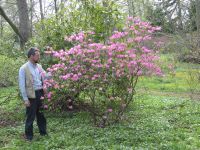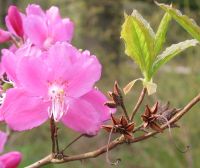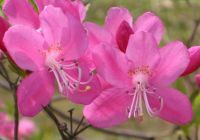Albrechts azalea - Rhododendron albrechtii
English name:
Albrechts azalea
Scientific name:
Rhododendron albrechtii
Family:
Ericaceae (heath family)
Height:
up to 2 M in our collection
Flowering:
Late April & early May
Range:
Japan, subalpine areas in mid Honshu to Hokkaido
 |
|
 |
 |
The 45 year oldRhododendron albrechtii in the picture is from seed received from Dortmund Botanic Garden. This species can be found under the collection of trees from the walnut family and in the Rhododendron valley, for example in square 2103.
Plant description:
This month I feature one of the early flowering Rhododendron albrechtii. Last year the flowering of Rhododendron peaked in week 19 (10-16 May) with over 30 species opening their flowers that week. This year, because of the cold period in late winter, the flowering for most species is expected to be delayed a week or two. This months plant, Rhododendron albrechtii, belongs to section Pentathera within the genus Rhododendron. Unlike most rhododendrons, all four species within this section do not hybridise with other species. Thus even an arboretum, like ours, with many species, produces pure seed for these species. Three of the species in this section are from Japan and the fourth (R. schlippenbachii) is from Korea and neighbouring areas in China.
Rhododendron albrechtii, like R. schlippenbachii is one of the more beautiful azaleas in the Arboretum. Its flowers are more vividly coloured that those of R. schlippenbachii but smaller in size. It seems well adapted to the cool summers of southern Scandinavia. We have 16 examples of Rhododendron albrechtii in our collection. Our oldest living plants came from the Dortmund Botanic Garden in 1958, other wild-collected specimens are from the Nordic Arboretum Expedition to Japan in 1976 or received from the American Rhododendron Seed Exchange program.
Rhododendron albrechtii was described from specimens collected by Dr. Albrecht in the 1860s while working for the Russian Consulate at Hokkaido. It remained unknown to cultivation in the west until 1914 when the Arnold Arboretum distributed seeds collected by E.H. Wilson. Nevertheless, it was still scarce in Europe for another 25 years. This is a bit surprising as R. albrechtii is widely distributed in central and northern Japan. I have not found information on when it was first introduced to Denmark, however, we have one specimen in the Forest Botanic Garden from circa1950.
These are deciduous shrubs often with bright yellow autumn leaf colour. The inverse egg-shaped leaves are spaced on vigorous shoots and in pseudo-whorls of 5 on short shoots. The margins and upper and lower surfaces are hairy. Young twigs and flower stalks can have sticky hairs. The flowers come in groups of 2-5, are 3-4 cm across. They open before or with the unfolding of the leaves and are rose to deep rose-purple in colour. The 10 stamens occur as an upper group of 5 short, and a lower group of 5 long stamens. The seed capsules are covered with glandular (sticky) hairs.
This is one of the better azalea species fro the woodland garden, although not so often grown in Denmark. There is no official Danish name. The colours although intense are less shocking than many of the modern azalea hybrids. Flowering in our specimens begins slightly before that of R. schlippenbachii. This species is doing well in both exposed and light shady sites in our collection. All our surviving, wild collected specimens are from Honshu Island in Japan.
References:
Jørgensen, Per M. 2003. Rhododendron i det norske arboret på Milde. 2nd addition, Vigmostad & Bjørke AS, Bergen. 264 pp.
Cox, P.A. 1990. The Larger Rhododendron Species. B.T. Bratsford Ltd. London 389 pp.
Cox, P.A. & Cox, K.N.E. 1997. The Encyclopedia of Rhododendron species. Glendoick Publishing, Perth Scotland. 396 pp.
Davidian, H.H. 1995. The Rhododendron Species. Vol IV. Azaleas. Timber Press Inc. Portland. 184 pp.
